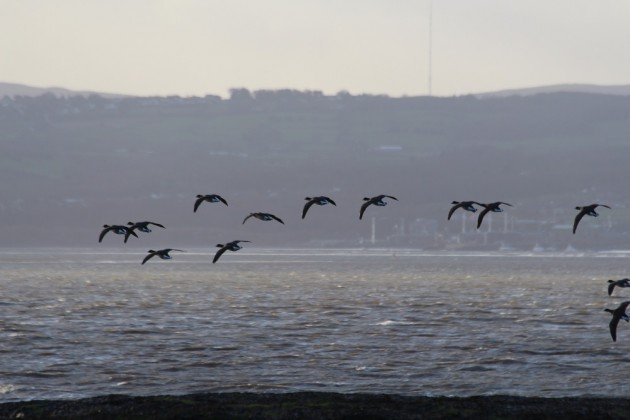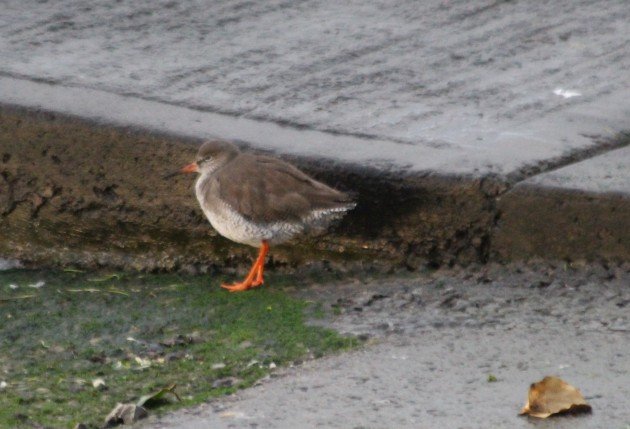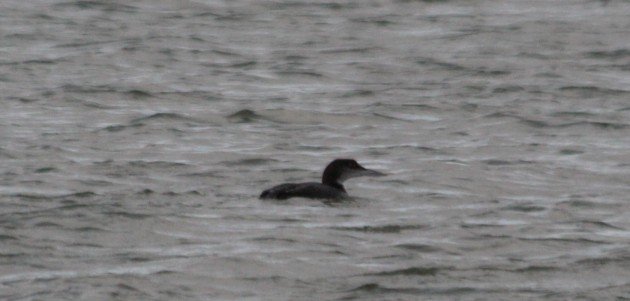One of my favourite walks when I visit my parents in England is the walk out to Hilbre in the Dee Estuary. The island is something of a sometimes island, a collection of rocks with a smattering of houses that is sometimes an island among the sandy expanses of the silted up estuary and sometimes actually an island in the Irish Sea. It sits on the edge of the Wirrall, a peninsula bounded by the Dee Estuary on the south and the Mersey Estuary to the north (of Liverpool fame). The Dee Estuary is a rich area for birders, especially those interested in wetland and shorebirds, and is an important wintering grounds for many of these. The area is excellently served by a detailed website with site guides and daily updates on what’s around.
That shower held driving rain that came sideways.
Hilbre is the place where the estuary meets the sea, making it a prized location in the region for sea-watching. It is easily reached during low tide by walking out across the sands (but follow the instructions on shore carefully!). During high tide the island is cut off, but people will deliberately strand themselves on the island to engage in six hours of solid sea watching in the hope of picking up species like Northern Fulmar, Leach’s Storm-petrels, skuas, sea ducks, loons and Manx Shearwaters. I’ve never felt the need to do that myself (mostly cause I lack a scope still) but the island has plenty to offer those not seeking hard birding.
This ruined…. something…. is where people shelter to seawatch
The shores around the big island hold a lot of species during the winter and around migration. What first attracted me to the island was the chance to see Brent Geese (Black Brants to North Americans) which can be found on the rocky shore (they used to number in the twenties when I first visited a decade ago but now there are hundreds) and the chance to see Grey Seals across the estuary on the sandy banks off North Wales. Among the same rocky shores as the geese can be found plenty of Eurasian Oystercatchers, Ruddy Turnstones, Eurasian Curlew and if you are lucky Purple Sandpiper. In the mud nearby can also be found many of the same species along with Herring Gulls, European Golden Plovers, Common Ringed Plovers, Grey Herons and Common Gulls (Mew Gull to colonial types). The island itself can also act as something of a migrant trap during migration, and it’s the only place I’ve ever seen Eurasian Linnet (a type of finch).

Brent Geese, with Wales behind
Hilbre looking north towards Liverpool
It’s worth stopping by the shore before you set out, as West Kirby, the town from which you set out to visit Hilbre, has a marine lake that attracts interesting species. The marine lake exists to give boaters something to do for the majority of the day when the tide is too low, and for that reason it’s worth visiting early before the boaters scare away some of the shier species. The star species this winter was a Common Loon (or Great Northern Diver as Brits persist on calling them), which hung around for months. While admiring this wonderful species I was also able to see a number of other great birds including Common Redshank, European Shag, Red-breasted Merganser, Great-crested Grebe and a lovely Rock Pipit.













This place looks amazing. Oh, how I miss the coast…
A couple of points:
(I) is Linnet one of the introduced European species in NZ?
(ii) Great Northern Diver is a much more appropriate name for such a magnificent bird than Common Loon!